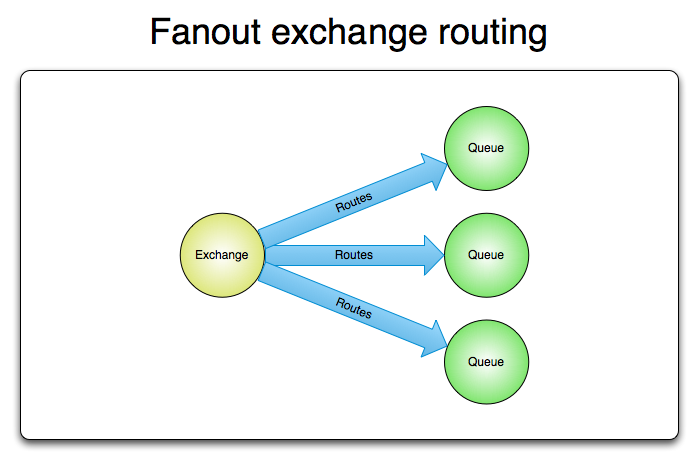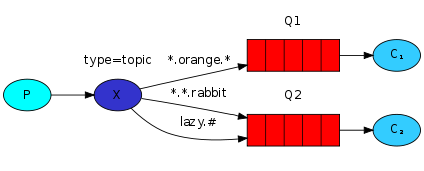您好,登錄后才能下訂單哦!
您好,登錄后才能下訂單哦!
rabbitmq怎么在springboot中使用?相信很多沒有經驗的人對此束手無策,為此本文總結了問題出現的原因和解決方法,通過這篇文章希望你能解決這個問題。
概述
RabbitMQ是一個開源的消息代理和隊列服務器,用來通過普通協議在完全不同的應用之間共享數據,或者簡單地將作業隊列以便讓分布式服務器進行處理。
它現實了AMQP協議,并且遵循Mozilla Public License開源協議,它支持多種語言,可以方便的和spring集成。
消息隊列使用消息將應用程序連接起來,這些消息通過像RabbitMQ這樣的消息代理服務器在應用程序之間路由。
基本概念
Broker
用來處理數據的消息隊列服務器實體
vhost
由RabbitMQ服務器創建的虛擬消息主機,擁有自己的權限機制,一個broker里可以開設多個vhost,用于不同用戶的權限隔離,vhost之間是也完全隔離的。
productor
產生用于消息通信的數據
channel
消息通道,在AMQP中可以建立多個channel,每個channel代表一個會話任務。
exchange
direct
轉發消息到routing-key指定的隊列
 fanout
fanout
fanout
轉發消息到所有綁定的隊列,類似于一種廣播發送的方式。
 topic
topic
topic
按照規則轉發消息,這種規則多為模式匹配,也顯得更加靈活
 queue
queue
queue
隊列是RabbitMQ的內部對象,存儲消息
以動態的增加消費者,隊列將接受到的消息以輪詢(round-robin)的方式均勻的分配給多個消費者。
binding
表示交換機和隊列之間的關系,在進行綁定時,帶有一個額外的參數binding-key,來和routing-key相匹配。
consumer
監聽消息隊列來進行消息數據的讀取
springboot下三種Exchange模式(fanout,direct,topic)實現
pom.xml中引用spring-boot-starter-amqp
<dependency> <groupId>org.springframework.boot</groupId> <artifactId>spring-boot-starter-amqp</artifactId> </dependency>
增加rabbitmq配置
spring: rabbitmq: host: localhost port: 5672 username: guest password: guest
direct
direct模式一般情況下只需要定義queue 使用自帶交換機(defaultExchange)無需綁定交換機
@Configuration
public class RabbitP2PConfigure {
public static final String QUEUE_NAME = "p2p-queue";
@Bean
public Queue queue() {
return new Queue(QUEUE_NAME, true);
}
}@RunWith(SpringRunner.class)
@SpringBootTest(classes = BootCoreTestApplication.class)
@Slf4j
public class RabbitTest {
@Autowired
private AmqpTemplate amqpTemplate;
/**
* 發送
*/
@Test
public void sendLazy() throws InterruptedException {
City city = new City(234556666L, "direct_name", "direct_code");
amqpTemplate.convertAndSend(RabbitLazyConfigure.QUEUE_NAME, city);
}
/**
* 領取
*/
@Test
public void receive() throws InterruptedException {
Object obj = amqpTemplate.receiveAndConvert(RabbitLazyConfigure.QUEUE_NAME);
Assert.notNull(obj, "");
log.debug(obj.toString());
}
}適用場景:點對點
fanout
fanout則模式需要將多個queue綁定在同一個交換機上
@Configuration
public class RabbitFanoutConfigure {
public static final String EXCHANGE_NAME = "fanout-exchange";
public static final String FANOUT_A = "fanout.A";
public static final String FANOUT_B = "fanout.B";
public static final String FANOUT_C = "fanout.C";
@Bean
public Queue AMessage() {
return new Queue(FANOUT_A);
}
@Bean
public Queue BMessage() {
return new Queue(FANOUT_B);
}
@Bean
public Queue CMessage() {
return new Queue(FANOUT_C);
}
@Bean
public FanoutExchange fanoutExchange() {
return new FanoutExchange(EXCHANGE_NAME);
}
@Bean
public Binding bindingExchangeA(Queue AMessage, FanoutExchange fanoutExchange) {
return BindingBuilder.bind(AMessage).to(fanoutExchange);
}
@Bean
public Binding bindingExchangeB(Queue BMessage, FanoutExchange fanoutExchange) {
return BindingBuilder.bind(BMessage).to(fanoutExchange);
}
@Bean
public Binding bindingExchangeC(Queue CMessage, FanoutExchange fanoutExchange) {
return BindingBuilder.bind(CMessage).to(fanoutExchange);
}
}發送者
@Slf4j
public class Sender {
@Autowired
private AmqpTemplate rabbitTemplate;
public void sendFanout(Object message) {
log.debug("begin send fanout message<" + message + ">");
rabbitTemplate.convertAndSend(RabbitFanoutConfigure.EXCHANGE_NAME, "", message);
}
}我們可以通過@RabbitListener監聽多個queue來進行消費
@Slf4j
@RabbitListener(queues = {
RabbitFanoutConfigure.FANOUT_A,
RabbitFanoutConfigure.FANOUT_B,
RabbitFanoutConfigure.FANOUT_C
})
public class Receiver {
@RabbitHandler
public void receiveMessage(String message) {
log.debug("Received <" + message + ">");
}
}適用場景
- 大規模多用戶在線(MMO)游戲可以使用它來處理排行榜更新等全局事件
- 體育新聞網站可以用它來近乎實時地將比分更新分發給移動客戶端
- 分發系統使用它來廣播各種狀態和配置更新
- 在群聊的時候,它被用來分發消息給參與群聊的用戶
topic
這種模式較為復雜,簡單來說,就是每個隊列都有其關心的主題,所有的消息都帶有一個“標題”,Exchange會將消息轉發到所有關注主題能與RouteKey模糊匹配的隊列。
在進行綁定時,要提供一個該隊列關心的主題,如“topic.# (“#”表示0個或若干個關鍵字,“*”表示一個關鍵字。 )
@Configuration
public class RabbitTopicConfigure {
public static final String EXCHANGE_NAME = "topic-exchange";
public static final String TOPIC = "topic";
public static final String TOPIC_A = "topic.A";
public static final String TOPIC_B = "topic.B";
@Bean
public Queue queueTopic() {
return new Queue(RabbitTopicConfigure.TOPIC);
}
@Bean
public Queue queueTopicA() {
return new Queue(RabbitTopicConfigure.TOPIC_A);
}
@Bean
public Queue queueTopicB() {
return new Queue(RabbitTopicConfigure.TOPIC_B);
}
@Bean
public TopicExchange exchange() {
TopicExchange topicExchange = new TopicExchange(EXCHANGE_NAME);
topicExchange.setDelayed(true);
return new TopicExchange(EXCHANGE_NAME);
}
@Bean
public Binding bindingExchangeTopic(Queue queueTopic, TopicExchange exchange) {
return BindingBuilder.bind(queueTopic).to(exchange).with(RabbitTopicConfigure.TOPIC);
}
@Bean
public Binding bindingExchangeTopics(Queue queueTopicA, TopicExchange exchange) {
return BindingBuilder.bind(queueTopicA).to(exchange).with("topic.#");
}
}同時去監聽三個queue
@Slf4j
@RabbitListener(queues = {
RabbitTopicConfigure.TOPIC,
RabbitTopicConfigure.TOPIC_A,
RabbitTopicConfigure.TOPIC_B
})
public class Receiver {
@RabbitHandler
public void receiveMessage(String message) {
log.debug("Received <" + message + ">");
}
}通過測試我們可以發現
@RunWith(SpringRunner.class)
@SpringBootTest(classes = BootCoreTestApplication.class)
public class RabbitTest {
@Autowired
private AmqpTemplate rabbitTemplate;
@Test
public void sendAll() {
rabbitTemplate.convertAndSend(RabbitTopicConfigure.EXCHANGE_NAME, "topic.test", "send All");
}
@Test
public void sendTopic() {
rabbitTemplate.convertAndSend(RabbitTopicConfigure.EXCHANGE_NAME, RabbitTopicConfigure.TOPIC, "send Topic");
}
@Test
public void sendTopicA() {
rabbitTemplate.convertAndSend(RabbitTopicConfigure.EXCHANGE_NAME, RabbitTopicConfigure.TOPIC_A, "send TopicA");
}
}適用場景
- 分發有關于特定地理位置的數據,例如銷售點
- 由多個工作者(workers)完成的后臺任務,每個工作者負責處理某些特定的任務
- 股票價格更新(以及其他類型的金融數據更新)
- 涉及到分類或者標簽的新聞更新(例如,針對特定的運動項目或者隊伍)
- 云端的不同種類服務的協調
- 分布式架構/基于系統的軟件封裝,其中每個構建者僅能處理一個特定的架構或者系統。
延遲隊列
延遲消費:
如用戶生成訂單之后,需要過一段時間校驗訂單的支付狀態,如果訂單仍未支付則需要及時地關閉訂單。
用戶注冊成功之后,需要過一段時間比如一周后校驗用戶的使用情況,如果發現用戶活躍度較低,則發送郵件或者短信來提醒用戶使用。
延遲重試:
如消費者從隊列里消費消息時失敗了,但是想要延遲一段時間后自動重試。
如果不使用延遲隊列,那么我們只能通過一個輪詢掃描程序去完成。這種方案既不優雅,也不方便做成統一的服務便于開發人員使用。但是使用延遲隊列的話,我們就可以輕而易舉地完成。
設置交換機延遲屬性為true
@Configuration
public class RabbitLazyConfigure {
public static final String QUEUE_NAME = "lazy-queue-t";
public static final String EXCHANGE_NAME = "lazy-exchange-t";
@Bean
public Queue queue() {
return new Queue(QUEUE_NAME, true);
}
@Bean
public DirectExchange defaultExchange() {
DirectExchange directExchange = new DirectExchange(EXCHANGE_NAME, true, false);
directExchange.setDelayed(true);
return directExchange;
}
@Bean
public Binding binding() {
return BindingBuilder.bind(queue()).to(defaultExchange()).with(QUEUE_NAME);
}
}發送時設置延遲時間即可
@Slf4j
public class Sender {
@Autowired
private AmqpTemplate rabbitTemplate;
public void sendLazy(Object msg) {
log.debug("begin send lazy message<" + msg + ">");
rabbitTemplate.convertAndSend(RabbitLazyConfigure.EXCHANGE_NAME,
RabbitLazyConfigure.QUEUE_NAME, msg, message -> {
message.getMessageProperties().setHeader("x-delay", 10000);
return message;
}
);
}
}看完上述內容,你們掌握rabbitmq怎么在springboot中使用的方法了嗎?如果還想學到更多技能或想了解更多相關內容,歡迎關注億速云行業資訊頻道,感謝各位的閱讀!
免責聲明:本站發布的內容(圖片、視頻和文字)以原創、轉載和分享為主,文章觀點不代表本網站立場,如果涉及侵權請聯系站長郵箱:is@yisu.com進行舉報,并提供相關證據,一經查實,將立刻刪除涉嫌侵權內容。